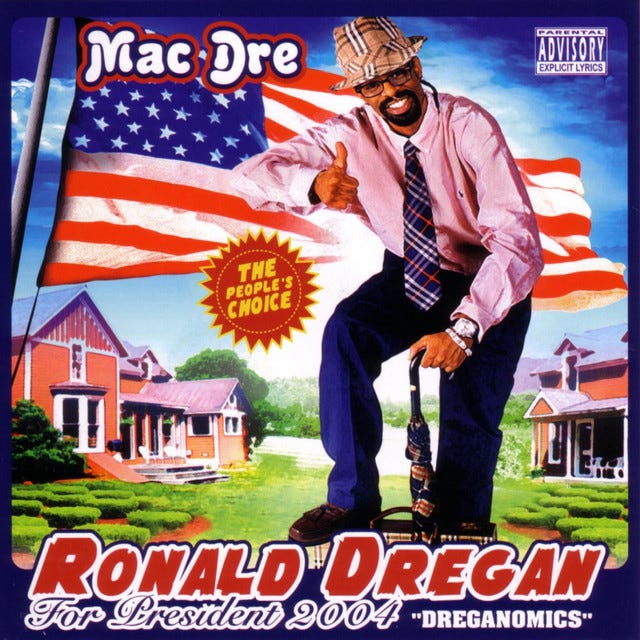Genre of the Day - Hyphy
Album of the Day - Ronald Dregan by Mac Dre (2004)
June 27, 2024
Cars. Jokes. Ecstasy. The Bay. It could be words in a hyphy verse; it could be an equally effective initial summary to lead into this article with. The Bay Area is an odd region to me. I’ve visited once, and I saw some charms, but I can’t say I don’t think it’s annoying when people are always mentioning that they’re from the Bay. I’m sure it’s lovely to be from the Bay. Every day you simply get to talk about being from the Bay and how this factoid is supposed to mean something intangible yet essential. Forgive me. After residing in LA for some time and hearing incessant chat about the Bay supposedly being so much better, I’ve internalized some disdain. I am forced to hold the magnifying glass closer today and atone for any anti-Bay sentiment within me. Let’s work it out on this article, in honor of Mac Dre.
Hyphy might just give the Bay a leg up in my heart. It’s wacky, zany hip-hop that underscores the sound of a region coming into its own within the hip-hop world and asserting its unique culture, strengthening community in the process and turning street legends into local moguls dealing in the culture’s growth. Like Atlanta’s crunk, hyphy was a movement with a near-political dedication to partying, if Mac Dre cosplaying as hyphy’s Reagan on today’s featured album cover tells you anything. It emerged full throttle in Vallejo in the northeast Bay in the early 2000s, though architects of the sound like E-40 and Mac Dre (who was temporarily stymied by a jail stint on robbery charges) had been laying the foundation throughout the ‘90s. Songs like E-40’s 1993 “Captain Save A Hoe” already features hyphy’s core elements: humor, instant-classic slang phrases, and funk-inclined sound of hyphy’s take on West Coast hip-hop. It features clapping emphases on the second and fourth beats, imported from the City of Angels, and a slapping kick on the first and second or third and fourth beats. The sound peaked in the mid-2000s, as hyphy’s figureheads weren’t able to keep the momentum of the movement going commercially, but the sound lives on in Bay natives’ hearts and in the sound of producers who have adapted it to new clubbing eras like DJ Mustard.
To become a veritable movement that would put Bay Area rap on the map, hyphy had to elevate the core elements of the music into a true subculture. The symbols of its rise manifested in car culture, new dances, and a down-to-earth communal nature. In the hyphy world, a little ecstasy never hurt either to make you go ‘hyper’—its name enshrines this, combining the words hyper and fly. While EDM is usually levied with the (accurate) ecstasy allegations, it’s integral to hyphy music to release inhibitions and thus come to the party ready to go. To thizz is to fully enjoy the ecstasy, more properly known in hyphy as a thizzle, to let it move you, to embrace it.
Though I have no stake in the argument, I must say hyphy’s colorful Wonka-esque term for ecstasy is vastly preferable to the bland ‘molly.’ I don't intend to glorify the use of MDMA. It’s simply a part of the genre, but it makes sense that it might become the drug of choice in a genre centered around unserious, unpretentious communal joy. After all, before being branded as ecstasy, in its early years and emergently today MDMA promised therapeutic potential as it intensifies feelings of empathy for others. You can write the central presence of ecstasy in the hyphy movement off as reckless party drug abuse. You can see it as a socioeconomically marginalized community glorifying the drug’s possibility to release tension and help people bond. The truth walks the line somewhere in the middle.
Mac Dre’s thizzing life and the fizzy energy he brought to all of his raps was cut tragically short after this album in one of hip-hop’s all-time most puzzling murders, but his legacy lives on in his proud love for and integral role in spreading hyphy culture. He possessed the bombast to establish himself as such with opener “Feelin’ Myself,” confidently pulling you into the screwball world of hyphy’s off kilter synthesizer effects and funky bass. He demands: “What do I look like / Mr. Frank Fuck for Free?”, a show-stopping amazingly alliterative bar that should enter the national vernacular either as a tongue-twister or saying. “Jump It” gives a taste into hyphy’s dance culture, wacky rhymes over subtle bass whirr and compressed guitar groove and percussion that recalls the shaking movements of dancehall. His humor is out-of-pocket, delightful most of the time and sometimes simply unpalatable here and there such as select lines of “Get Stupid.” Though the set is generally a party rivaling Mardi Gras as Mac Dre suggests on a couple of tracks, and his colorful bars and kooky beats certainly rival the festival, the warning of “Don’t Snitch” reminds you that it’s not all fun and games. Even so, its bouncy, robotic bass lends it a danceable flair that makes you move even when trying to listen up. Whether thizzing or not, Mac Dre’s hyphy still accomplishes its primary goal—to make you loosen up and embrace this hyper-fly vision of life.




